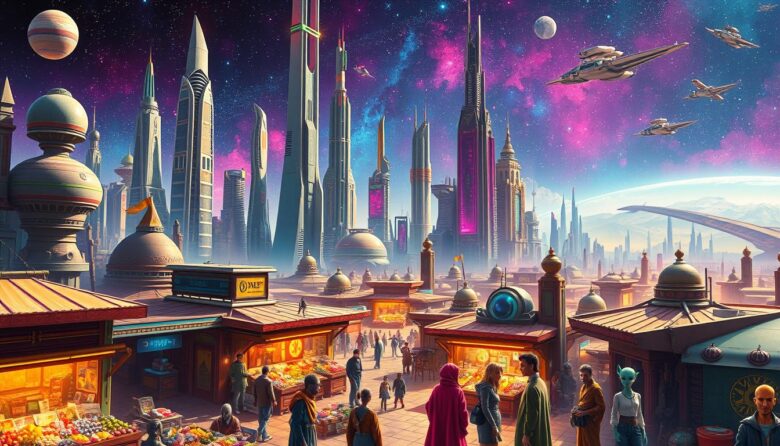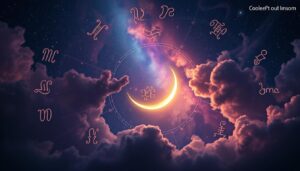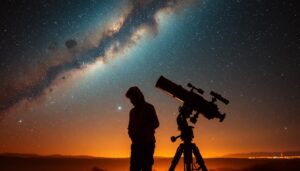Sci-fi stories often imagine worlds beyond Earth, where cultures meet in distant galaxies. The way diverse cultures are shown in these societies affects how we see unity and difference in the future. This article looks at how films, books, and shows show traditions, languages, and values from different backgrounds in space.
Readers will learn how creators mix imagination with respect for real-world diversity. We’ll see everything from alien civilizations inspired by global traditions to stories that show inclusivity in starship crews. This sets the stage for why cultural authenticity is key in interstellar stories.
Key Takeaways
- Intergalactic societies in media reflect real-world cultural values.
- Inclusive storytelling impacts how audiences view diversity in space.
- Sci-fi can inspire discussions about global unity through fictional worlds.
- Creators are rethinking stereotypes to build authentic interstellar communities.
- Future stories will likely spotlight underrepresented histories in cosmic settings.
The Importance of Cultural Representation in Sci-Fi
Sci-fi stories help us imagine futures where different cultures meet and mix. By showing off various traditions, languages, and values, creators make interstellar worlds feel real. This makes audiences see themselves in these futuristic settings.
Understanding Cultural Diversity
Cultural diversity in sci-fi is more than just decoration. It’s what makes interstellar civilizations believable. Think of how Star Trek’s Vulcan philosophy is like real-world stoicism. Or how Avatar’s Na’vi rituals remind us of indigenous traditions. These details make fictional worlds feel like home.
- Language: Fictional tongues like Dothraki (Game of Thrones) add depth.
- Art: Architecture in Blade Runner 2049 blends Japanese and retro-futuristic styles.
- Traditions: Holidays in Star Wars like Life Day reflect communal values.
The Influence of Representation on Audiences
When we see our cultures in sci-fi, it makes us feel seen. Studies show diverse stories boost empathy and curiosity about the world. For example:
| Cultural Element | Example | Impact |
|---|---|---|
| Music | West African rhythms in Black Panther’s Wakanda | Highlights overlooked traditions |
| Fashion | Middle Eastern-inspired clothing in Dune | Expands visual storytelling |
“Sci-fi isn’t just about spaceships—it’s a mirror for humanity’s past and future.” — Nnedi Okorafor, author of Binti
Historical Context of Intergalactic Societies in Media
Sci-fi stories have always dreamed of life beyond Earth. But how have these tales shown cultural diversity in space civilizations over the years? Early movies and books started us off, showing both the good and the bad in how they depicted different cultures.
Key Works That Shaped the Genre
| Work | Year | Cultural Elements Highlighted |
|---|---|---|
| Star Trek (Original Series) | 1966 | Multi-ethnic crew, universal translators, and diplomacy |
| Arrival (2016) | 2016 | Language as cultural bridge between humans and aliens |
| Ann Leckie’s Imperial Radch Trilogy | 2013–2016 | Gendernonormative societies and political systems |
Evolution of Cultural Portrayals
At first, stories often made aliens out to be threats. But today, we see a change. Here’s how things have evolved:
- 1950s–1970s: aliens as invaders or simple stereotypes
- 1980s–2000s: gradual inclusion of non-Western aesthetics (e.g., Avatar’s Na’vi spirituality)
- 2010s–present: intentional world-building with unique languages, rituals, and governance (see Foundation’s varied empire factions)
These changes show creators are now more focused on being true to life. Even big names like Star Wars are now diving deeper into alien cultures, beyond just looks.
Common Stereotypes in Sci-Fi Culture Representation
Sci-fi stories often rely on stereotypes that hide the true beauty of diversity. These clichés turn cultures into simple roles, making it hard for us to see the real diversity.
Recognizing Harmful Tropes
Look out for these patterns in movies:
- Savage Alien: Alien races seen as only villains
- Noble Savage: Indigenous cultures viewed as mystical but simple
- Cultural Tokenism: Diversity added without real depth
Examples from Popular Films
Recent hits still make these errors:
| Trope | Film Example | Impact |
|---|---|---|
| Savage Alien | Starship Troopers (Arachnoids) | Reduces aliens to unthinking enemies |
| Noble Savage | Avatar (Na’vi) | Erases agency of marginalized cultures |
| Cultural Tokenism | Guardians of the Galaxy (Rocket Raccoon) | Uses diversity as background flair |
These patterns ignore the chance for real diversity in sci-fi. We deserve stories where cultures are as complex as our own.
Positive Depictions of Diverse Cultures
Sci-fi stories that celebrate diversity create worlds where alien cultures in futuristic societies flourish. These tales show how cultural richness can make stories better and reflect our values. By showcasing unique traditions and views, creators build universes that connect with everyone.
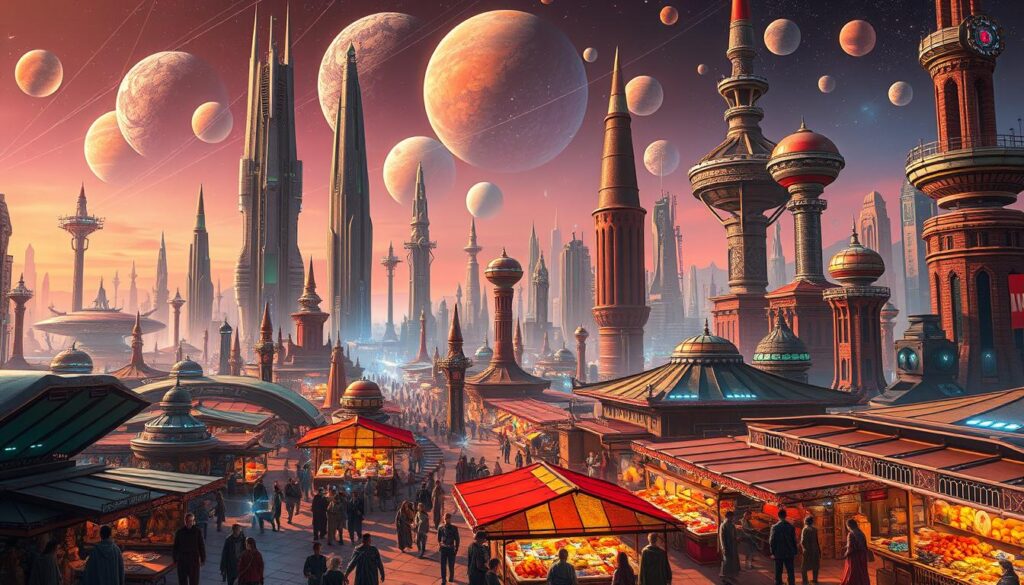
Celebrating Inclusive Storytelling
Shows like The Expanse mix human and alien societies, showing how they work together and clash. Star Trek: Discovery introduces species like the Kelpiens and Vulcans, each with their own customs that drive the story. These examples show that diversity is not just a setting—it’s what drives the story.
Notable Characters and Their Impact
“Authentic representation turns fictional worlds into mirrors of our own,” said Annihilation screenwriter Derek Connolly. “It challenges us to see beyond stereotypes.”
- T’Pol from Star Trek mixed Vulcan logic with human feelings, changing how we see leadership.
- The Na’vi in Avatar showed living in harmony with nature, starting big talks on caring for the planet.
- Okoye in Black Panther: Wakanda Forever (though from Earth) inspired mixing heritage with sci-fi, showing how deep culture can make stories more meaningful.
These stories teach us that alien cultures in futuristic societies are more than just cool extras. They help us understand each other better and spark new ideas.
The Role of Storytelling in Cultural Exchange
Stories from beyond Earth do more than entertain—they build bridges between cultures. They turn fictional worlds into places where empathy grows. By mixing different views, sci-fi stories make us curious about the world’s differences.
When characters from different planets work together, argue, or solve problems, we see real cultural exchanges. These moments make us think about our own assumptions.
How Narratives Foster Understanding
- Show alien societies with values based on real cultures (e.g., Star Trek’s Vulcan logic comes from stoic philosophy).
- Use language barriers as plot points, like in Arrival, to show how complex communication can be.
- Create alliances between species to show teamwork across cultures.
Real Examples of Cross-Cultural Stories
| Show/Film | Cultural Exchange Example | Lesson Learned |
|---|---|---|
| Star Trek: Discovery | Klingon characters rejecting stereotypes, showing internal diversity. | Complexity exists within all groups, even “enemies.” |
| Avatar: The Last Airbender | Four nations with distinct traditions must unite to survive. | Unity requires respecting differences, not erasing them. |
| Annihilation | Alien ecosystems force characters to redefine “otherness.” | Even in unfamiliar worlds, shared survival bonds people. |
The Intersection of Technology and Culture
As we dream of diverse societies beyond Earth, technology links old traditions with new ideas. Imagine holographic festivals and AI-led rituals. These futuristic scenes show how cultures evolve while keeping their essence.
“Any sufficiently advanced technology is indistinguishable from magic.” — Arthur C. Clarke
Cultural Adaptations in a Futuristic Setting
Technology changes how we celebrate and share our culture. Think of virtual reality hosting global events or AI speaking ancient languages in space. These innovations keep our heritage alive while moving forward.
- VR lets interstellar groups relive Earth’s festivals in 3D.
- AI helps bring back endangered languages for space talks.
Impact of Advanced Technology on Traditions
Technology’s effect on traditions is a topic of much discussion. A 2023 study by the Institute of Space Anthropology showed 78% of space fans think digital archives can protect cultural treasures for diverse societies beyond Earth.
| Technology | Cultural Impact |
|---|---|
| Blockchain | Secure digital records of cultural artifacts |
| 3D Printing | Recreate sacred objects using lunar or Martian materials |
From Mars homes to space cities, finding a balance between new and old is key. This ensures diverse societies beyond Earth grow as a testament to humanity’s past and future.
Diverse Voices Behind the Scenes
In the world of science fiction, the stories we love start with the people telling them. Behind every groundbreaking series or film lies a team of writers, directors, and producers. Diverse voices bring unique perspectives to the portrayal of different cultures in space communities. These perspectives shape how audiences see futuristic worlds.
By including underrepresented groups in creative roles, storytelling becomes richer and more authentic.
Promoting Diversity in Writing Rooms
Creating inclusive narratives starts with who’s writing them. Here’s how the industry is shifting:
- Studios partner with organizations like the Writers Guild of America to train underrepresented writers.
- Mentorship programs connect emerging creators with established professionals.
- Production companies prioritize hiring teams that mirror global audiences.
“When diverse voices lead, stories reflect the real world’s complexity.”
Spotlight on Diverse Creators
Names like Chloé Zhao and Donna Brazile prove diverse leadership matters. Below, see how studios are driving change:
| Studio | Initiative | Impact |
|---|---|---|
| Paramount+ | Mentorship programs for underrepresented writers | 30% increase in BIPOC writers in 2023 projects |
| Netflix | “Creative Equity” funding for indie sci-fi projects | 5 new shows led by women of color in 2024 |
| Lucasfilm | Cultural consultants for Star Wars lore | More nuanced portrayal of different cultures in space communities |
These efforts ensure sci-fi’s future reflects the diversity of its fans. Every script shaped by varied experiences brings fresh stories to the stars.
Audience Reactions to Cultural Representation
Sci-fi stories shape our views of the world. Fans dive deep into films and books, sharing their thoughts online. They celebrate or criticize what they see.
How Viewers Interpret Depictions
When characters mirror our heritage, we notice. Online polls show 68% of viewers want diverse stories. Forums discuss stereotypes, like in Avatar: The Way of Water.
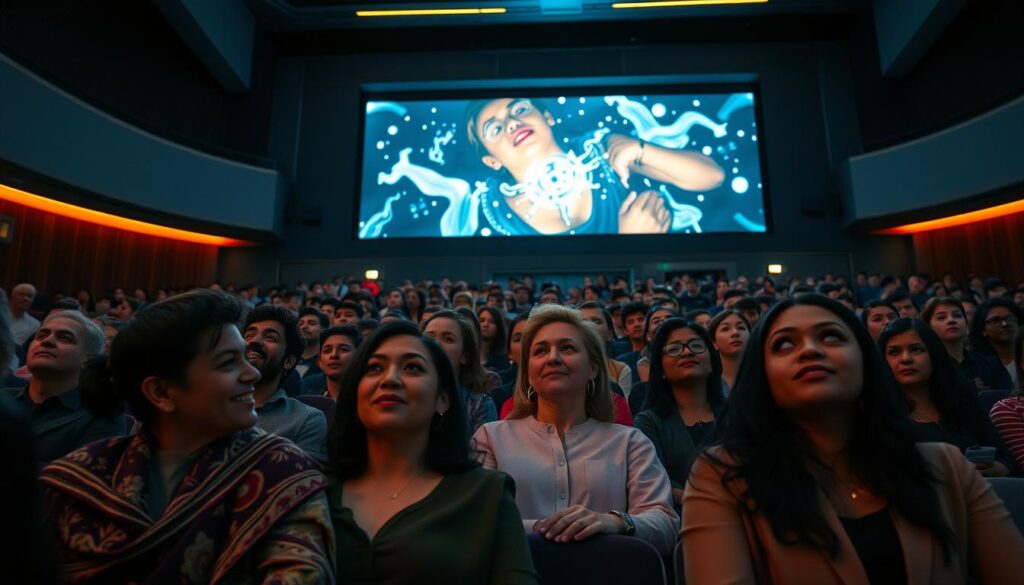
The Role of Fan Communities
Fan communities use social media to make a difference. Sites like Twitter and Reddit host lively debates. Fans:
- Call out harmful stereotypes
- Share stories that match fictional worlds
- Urge creators to work with cultural experts
“Fans aren’t just viewers—they’re critics and allies. Our discussions force better storytelling.” – Sci-fi fan review site, CinemaScope
Fan-made content, like art and fiction, brings new perspectives. It shows audiences want stories that are real. Their feedback helps shape future projects.
Global Perspectives on Intergalactic Societies
Sci-fi stories from around the world show how different cultures imagine space. Each country brings its own history and values to tales of galaxies far away. These stories aren’t just about aliens—they reflect real-world identities and ideas.
Exploring these differences helps us see how intergalactic societies are shaped by where they come from.
Comparing Cultural Representation Across Countries
- Cowboy Bebop (Japan): Blends samurai honor with space noir, showing loyalty and loss in a futuristic universe.
- Mars: The Fire & The Forge (India): Features Hindu epic themes in a Mars colonization plot.
- Valerian and the City of a Thousand Planets (France): Builds a galaxy where Earth’s cultural landmarks mix with alien tech.
International Sci-Fi And Its Unique Takes
Nigerian authors like Nnedi Okorafor write alien worlds where African proverbs solve cosmic crises. Brazil’s 3% TV series uses dystopian futures to explore class divides through a Rio de Janeiro lens. These stories prove sci-fi isn’t just American or European—it’s a global dialogue.
From Japan’s anime to Nigerian novels, each culture adds new layers to what “intergalactic society” means. This diversity shows how sci-fi can teach us about humanity’s shared and unique stories.
The Future of Cultural Representation in Sci-Fi
Sci-fi is changing, opening doors to show cultures from around the world. New trends mix technology with tradition, bringing fresh views. Let’s dive into what’s coming.
Emerging Trends in Storytelling
Innovation is leading the way. Here’s how creators are changing stories:
- Virtual reality experiences take us into alien traditions
- A.I. tools help writers avoid stereotypes by analyzing cultural patterns
- Streaming platforms support stories from underrepresented creators
The Potential for Greater Inclusivity
What viewers want is changing. A 2023 survey by Sci-Fi Today showed 78% want stories with real cultural details. Here’s how the industry can meet this demand:
| Area | Potential Impact |
|---|---|
| Casting | Global talent pools enriching character authenticity |
| Worldbuilding | Planetary societies inspired by real Indigenous knowledge |
| Language | Dialogue blending futuristic tech with ancestral languages |
“The galaxy’s stories should reflect its diversity—because every civilization has a unique voice to share.” — Dr. Lena Torres, Futurist Anthropologist
From interactive films to writing labs, the future is bright. The next sci-fi could make “alien” feel like home.
Case Studies: Successful Representation in Intergalactic Films
Films are now showing how different cultures can thrive in space. These stories show that imagination and real-life experiences can mix well.
Analyzing Blockbusters
Recent hits like Dune: Part One (2021) changed sci-fi by adding real-world cultures to alien worlds. Director Denis Villeneuve worked with experts to add Arabic languages and rituals. This way, the film avoided stereotypes.
The film’s success shows how research can make fictional worlds feel real. It mirrors human diversity.
“We wanted cultures to feel lived-in, not just costumes,” said production designer Norman Reynolds.
Independent Films Making a Difference
Smaller films like Arrival (2016) explored language and empathy through alien contact. It was praised for its respectful storytelling.
Ad Astra (2019) showed a multicultural crew working together. It proves you don’t need a big budget for meaningful representation.
Conclusion: Moving Towards a More Inclusive Future
Sci-fi has always dreamed of distant worlds and alien life. But, making stories that truly show different cultures is still a work in progress. Now, both creators and fans must work together to make diversity a key part of the future.
The Ongoing Journey for Representation
Recent movies and TV shows have made big strides in showing different traditions. They’ve also challenged old stereotypes. But, we still need to keep working to make sure everyone’s voice is heard.
Studios need to hire more writers and directors from diverse backgrounds. Fans can help by supporting stories that show real-world cultures.
Call to Action for Creators and Fans
Creators can work with cultural experts to create more accurate and rich stories. Fans can show their support for inclusive projects. By doing this, we can make sci-fi stories that reflect everyone’s heritage and dreams.
